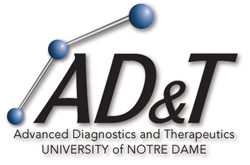
A team in the Advanced Diagnostics & Therapeutics (AD&T) Initiative at the University of Notre Dame has been awarded a grant of $359,281 for the development of a room-temperature, portable terahertz (THz) imaging system from the National Science Foundation (NSF) via the Integrative, Hybrid and Complex Systems (IHCS) program.
Led by Research Assistant Professor Lei Liu, Associate Professor Grace Xing and Professor Patrick Fay of the Department of Electrical Engineering, the team is working to develop an imaging device and nano-scale detectors that would create such a system, one that would more affordably capture high-quality images in real time at room temperature.
According to Liu, who will design the overall system and test the THz detectors developed by the team, the entire system would operate like a camera but in the submillimeter-wave and THz range of the electromagnetic spectrum — between radio frequency and the optical region.
“The development of such a system is important, not only because it does not require extensive cooling equipment but also because of the potential applications it enables across a variety of fields,” he said.
THz waves (and subsequent imaging systems) are ideal for medical applications because they are non-ionizing, meaning they do not damage living tissue in the same way that X-rays can. They are able to provide high-resolution images because of their short wavelengths, and this wavelength range also provides the ability to detect differences in tissue density more effectively than X-rays. For example, even though breast magnetic resonance imaging machinery does not use ionizing radiation, the units themselves are bulky and do not always provide accurate images. The system that the Notre Dame researchers are developing shows promise in enhanced cancer diagnostics, the early identification of disease biomarkers and increased quality of pharmaceuticals, detecting impurities or defects.
In addition, submillimeter-wave and THz waves can penetrate fabrics, plastics and cardboard, so they can easily be used in security applications to reveal concealed weapons or devices. In military applications, they could also prove useful by more effectively targeting specific ranges of materials or objects, as well as being able to accurately sense traces of explosive elements.
The goal of the IHCS program is to design, develop and implement novel complex and hybrid systems that lead to innovative engineering solutions for a variety of fields including, but not limited to, healthcare, medicine, the environment, communications, disaster mitigation, homeland security, transportation, manufacturing, energy and smart structures.
Established in 2008, AD&T is an interdisciplinary research initiative focused on developing diagnostic and therapeutic technologies at the smallest molecular scales to address a diverse set of health and environmental challenges.
For more information about research initiatives within the AD&T, visit http://advanceddiagnostics.nd.edu.